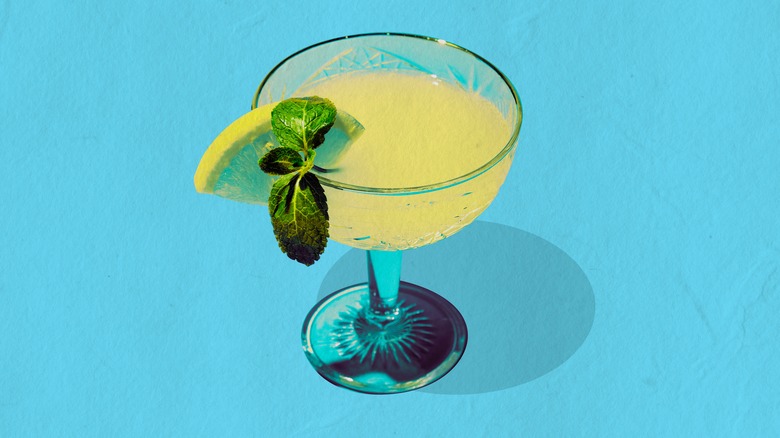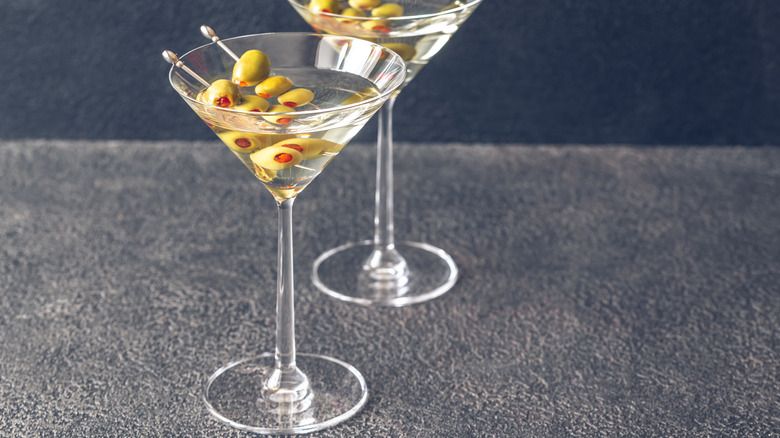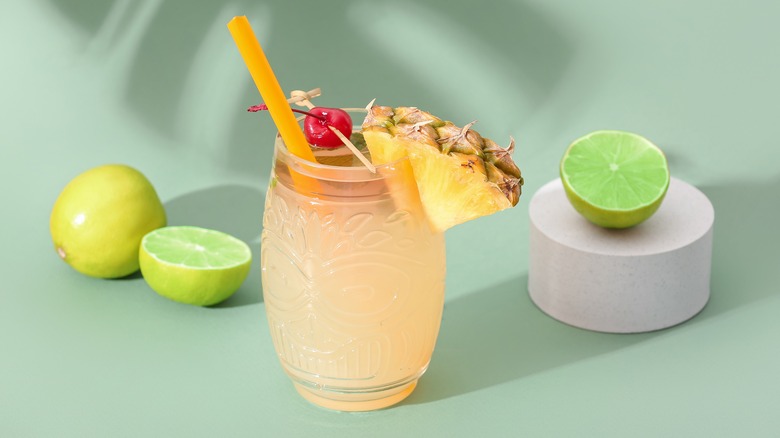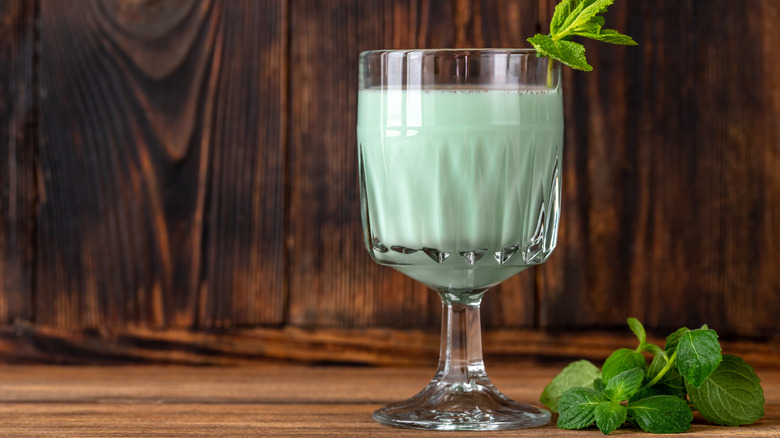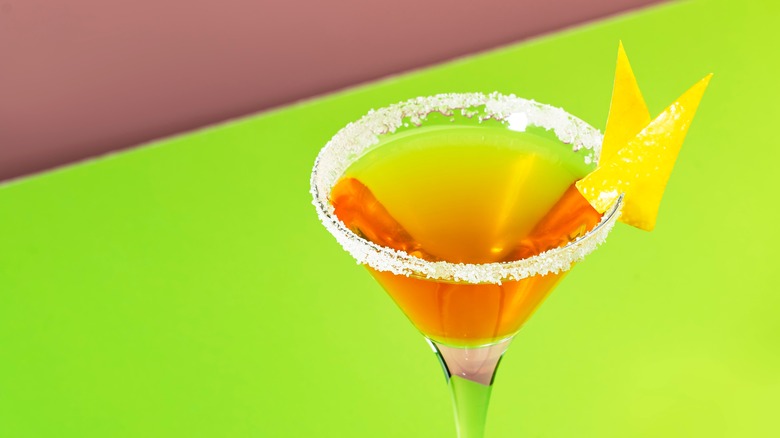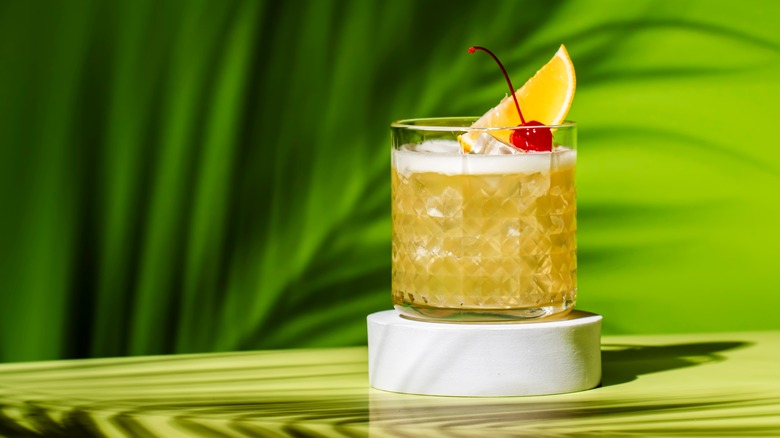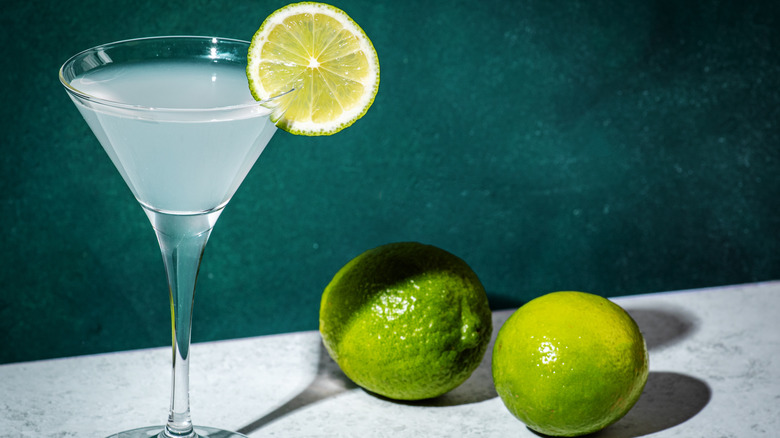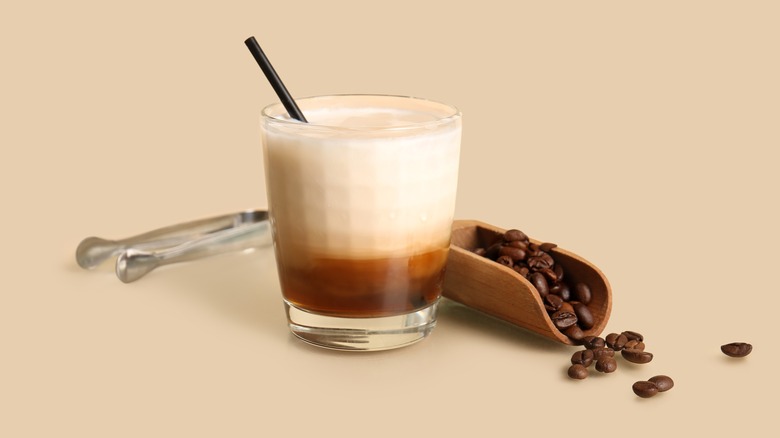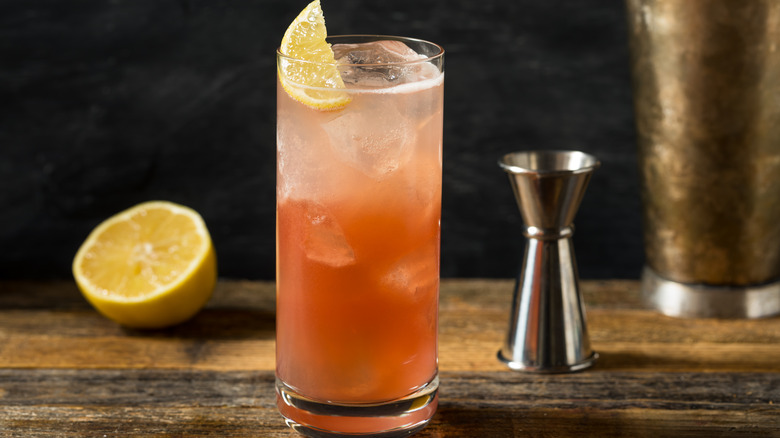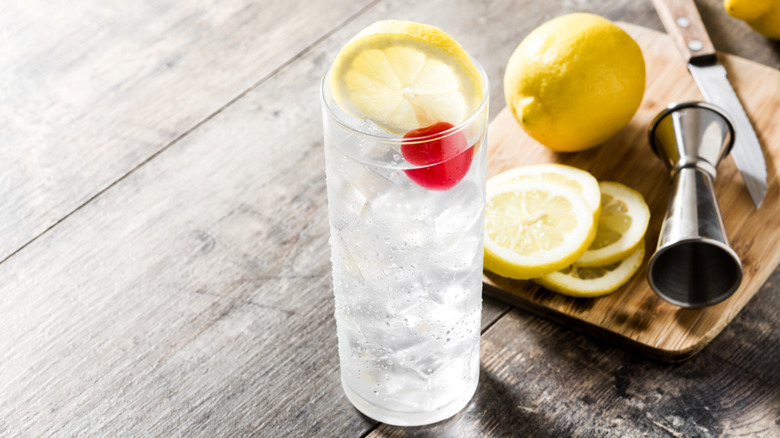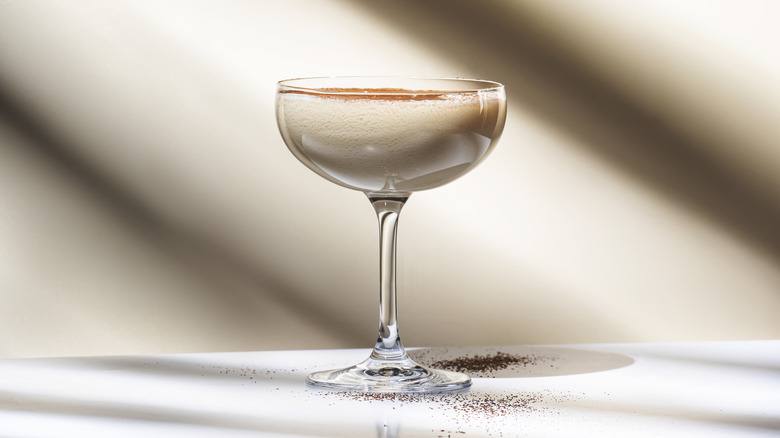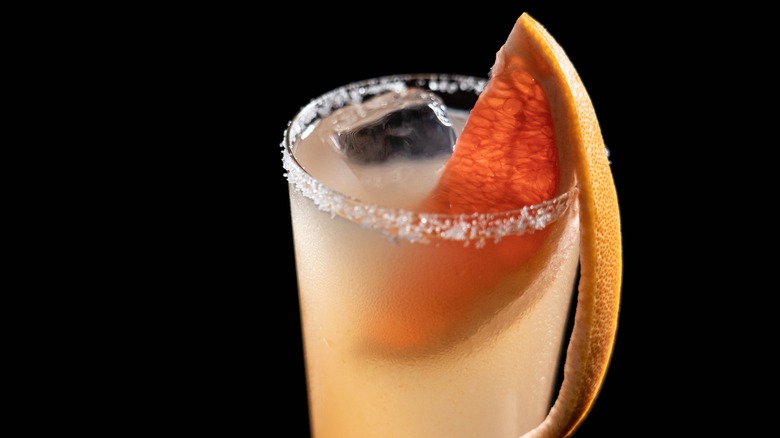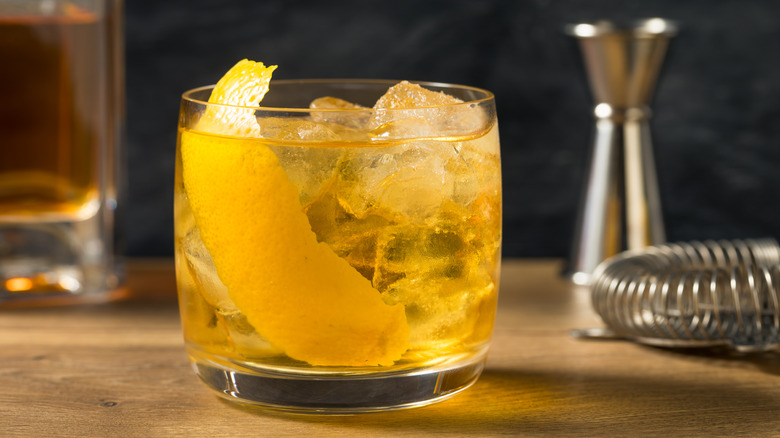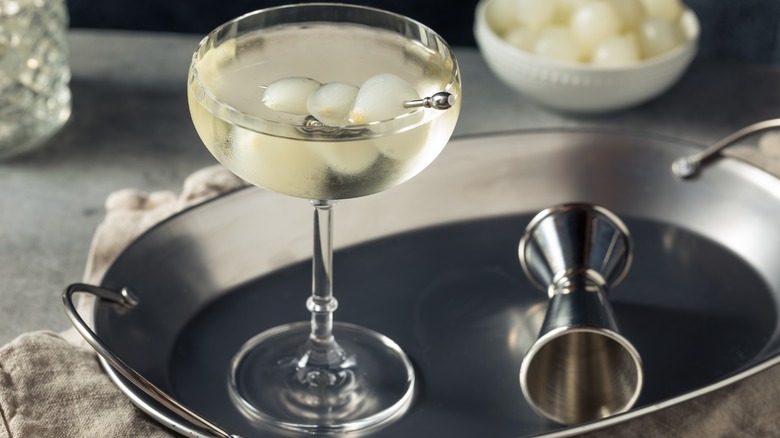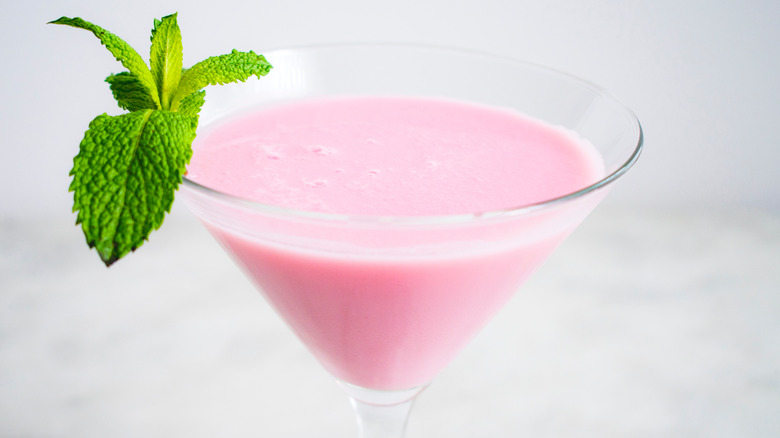14 Nostalgic 1960s Drinks Making A Comeback
The swinging '60s have a lot of appeal — the fashion, the music, and of course, the cocktails. Many boozy drinks that folks enjoyed during this decade were invented long before the era of the Space Race, color television, and Beatlemania, but are most closely associated with the 1960s because that's when they reached the apex of their popularity. Some cocktail historians criticize the drinks of this era as being uncreative, unbalanced, too sweet, and lacking in quality ingredients. Even so, these recipes have endured into the 21st century, and many are being rediscovered and revamped by modern mixologists.
Thanks to the craft cocktail movement, most bars these days stock much better ingredients than you'd have found in the sixties — fresh juices are the norm, for example, as opposed to the preservative-filled bottled juices and sweetened cordials of the past. These developments have allowed bartenders to reimagine and rebalance old recipes, giving them a new life and allowing them to appeal to more discerning modern drinkers. Here are some of the 1960s' favorite cocktails that you might see cropping up at a bar near you as they make a comeback.
1. Vodka Martini
One major development in the 1960s was the rise of vodka as a popular spirit. Part of this was due to the James Bond films, six of which graced cinema screens during the decade, starting with "Dr. No" in 1962. While Agent 007 drinks other things in both the books and movies, from vespers to beer to fine Champagne, it's the vodka martini that became his signature beverage — shaken, not stirred, of course. Bond's preference for the neutral spirit made it easier for Americans to accept it, despite the anti-Russian sentiment of the Cold War. Around this time, vodka overtook gin as the clear spirit of choice in the U.S., and the vodka martini followed suit.
As modern bartenders and mixologists rediscovered pre-Prohibition cocktails and classic recipes, gin made its way back into the hearts of martini drinkers everywhere. Vodka got a bit of a bad rap during the onset of the craft cocktail movement, thanks to its neutral, somewhat antiseptic taste and lack of character. But that attitude is slowly falling away as people are giving it more credit as a quality spirit, and as craft distillers are creating vodkas with unique flavor profiles and textures. The subtlety of an ice-cold martini made with high-quality vodka offers a sophisticated drinking experience that's worthy of a respectful comeback.
2. Mai Tai
Tiki culture has been around in the United States for a long, long time, with the allure of the South Pacific capturing people's imaginations as far back as the 19th century. Hawai'i officially became a state in 1959, lending fuel to the fiery mystique of tropical island culture. As rum made its way from the Caribbean to the U.S., cocktail recipes came along with it, and the bright, colorful, kitschy world of tiki culture took hold. Perhaps no drink embodies the tiki spirit like the mai tai, one of the most popular drinks of the 1960s.
A traditional mai tai, which was invented in the 1940s, is a rum-forward drink, with hints of sweetness and nuttiness from orgeat, an almond syrup, as well as simple syrup and orange curacao. The sweetness is balanced by fresh, zesty lime juice and the bright aromatics of a mint leaf garnish. It's a fairly simple, boozy drink that celebrates the complex flavor of aged rum. Once the drink became a tropical tourist staple in Hawai'i and reached its sixties peak of popularity, it had morphed into a sweet, juice-laden concoction, virtually unrecognizable from its original iteration. Nowadays, with tiki culture having its own craft cocktail renaissance, the traditional recipe has become celebrated once again by casual drinkers and hardcore mixologists alike.
3. Grasshopper
If you frequent serious cocktail bars and restaurants with lauded beverage programs, you may have noticed that sweet dessert cocktails are popping up on more and more menus. These types of drinks, often involving heavy cream and sweet liqueurs, were quite popular in the 1960s, but fell out of favor as modern drinkers embraced drier flavor profiles and began considering these sweet cocktails frivolous and for immature palates. In its sixties heyday, though, the bright green grasshopper had a huge fanbase, and it's difficult to blame them — the drink, a simple combination of crème de menthe, crème de cacao, and cream, tastes just like a Thin Mint cookie or a scoop of chocolate chip mint ice cream. It's not hard to like.
Serious booze enthusiasts may have celebrated the fall in popularity of drinks like the grasshopper, but the tides are turning in recent years as drinkers are rediscovering the delight of dessert cocktails. The grasshopper's vibrant color and fun retro vibe are certainly part of its appeal, and it makes a great nightcap after a meal with its combination of richness and fresh flavors. The world of liqueurs has also evolved since the sixties, with high-quality artisanal products now widely available, allowing for more elegant and complex versions of drinks like the grasshopper to grace high-end bar menus everywhere.
4. Sidecar
The sidecar is a cocktail of pure simplicity and classic elegance. Brandy, orange liqueur, and lemon juice are the only ingredients, giving it a rich yet refreshing flavor profile and a nice balance of sweetness and boozy strength. It's no wonder this drink has stood the test of time, although its popularity has waxed and waned through the decades. It was very popular in the 1960s, when it was most often made with Cognac, France's most prized style of brandy, and Cointreau as the orange liqueur, giving the drink a distinctive French vibe. The sugared rim appears in some recipes and is left off others, but seems to be a remnant of the drink's ancestor, the brandy crusta from the 19th century.
Despite the fact that brandy consumption is falling, the sidecar is once again surging in popularity. Its classic sophistication fits right in with the craft cocktail world, while its simplicity makes it accessible to just about everyone. It can also be easily rebalanced and tweaked to fit many different palates — rimmed with sugar and heavy on the orange liqueur for those who want it sweet, focused on citrus for those who want it zesty and refreshing, and brandy-forward for drinkers who like a strong, spiritous sipper.
5. Whiskey Sour
A classic whiskey sour is a thing of beauty: Whiskey of choice, freshly squeezed lemon, a little bit of simple syrup or just plain sugar. Egg white is an optional addition, shaken until the drink has an airy, frothy crown. When this cocktail was at the heyday of its popularity in the 1960s, however, it was most likely made with mass-produced bottled sour mix rather than fresh citrus, without egg white, and sometimes topped with seltzer. This meant the drink was simpler to make, but also lost much of its charm.
Today's bartenders aren't afraid to use egg whites in cocktails, which produce a lovely light foam — or aquafaba, a vegan-friendly option which is often used in its place, to avoid the small risk of salmonella from raw eggs. This lightens up the whiskey nicely, though you can leave it out if you like a heavier texture. It's also sometimes served up martini-style, sometimes on the rocks. Whichever way you prefer it, the classic whiskey sour is most certainly back in style.
6. Gimlet
Like many of these '60s drinks, the gimlet has actually been around for ages. Citrus has long been used to combat scurvy, a disease caused by vitamin C deficiency that was a rampant danger for sailors in past centuries. Fresh fruit wouldn't last on long journeys so eventually, in the late 19th century, a sweetened shelf-stable syrup was invented, known as Rose's lime cordial. To help it last longer — and go down easier — it was mixed with gin. And just like that, the gimlet was born.
With only two ingredients, three if you count the garnish, the gimlet's popularity soared through the decades in part thanks to its simplicity. While it was classically a gin-based cocktail, vodka's ascendance as America's favorite spirit made its way into the recipe instead, becoming a popular variation in the 1960s, illustrated in the show "Mad Men" as Betty Draper's signature cocktail.
Many people lost the taste for Rose's lime cordial as cocktails moved away from canned and bottled ingredients to focus on fresher flavors, and the traditional gimlet fell by the wayside. As interest in pre-Prohibition cocktails grew, it was rediscovered, made with a combination of simple syrup and freshly squeezed lime juice. Now, things are coming full circle, and the original recipe, stirred with lime cordial, is making it's own comeback. Many mixologists are making hand-crafted cordials, putting their own spin on the classic drink.
7. White Russian
Before the White Russian made its way back into mainstream culture with the '90s movie "The Big Lebowski," it had languished in the shadows since its popularity peak in the '60s. The earliest recipe for the drink was published in 1961 and its delectable combination of coffee liqueur and cream, along with vodka to up the booziness, became a household name. When sweet, creamy drinks fell out of fashion, the White Russian went along with the trend, and became the kind of drink you might order your first time at a bar, but eventually grow out of.
Today, however, the stigma of drinks like the White Russian is gone, as bartenders and drinkers alike are embracing sweeter dessert-style cocktails. Upgrading these classic recipes with innovative and high-quality ingredients is giving them new life and new popularity. While the original recipe calls for Kahlua, nowadays there's a multitude of coffee liqueurs to choose from, each with its own unique style and flavor. Heavy cream can be replaced by oat milk or horchata. The cocktail can even be clarified to remove dairy solids, giving you the flavor of a traditional White Russian with a silky, elegant texture. It's amazing to think the White Russian was ever unpopular — boozy, creamy coffee is one of life's tastiest pleasures.
8. Sloe Gin Fizz
If you're not familiar with sloe gin, don't fret. This is a somewhat niche product that hails from the United Kingdom, and its popularity elsewhere has ebbed and risen a lot over the years. It's a liqueur made from the fruit that grows on blackthorn hedges, plants which are ubiquitous throughout Great Britain, as they're commonly used as hedgerows. These fruits (often called sloe berries, although they're not technically berries) are harvested in autumn, and are used to create an infused liqueur (called sloe gin, even though it's not technically gin).
The sloe gin fizz is arguably the best-known cocktail featuring this liqueur. This drink features the brambly, tart, and fruity sloe flavor along with lemon juice and sugar, and sometimes egg white, topped with soda. The cocktail was invented in the late 1800s, but had a real wave of popularity in the 1960s. After that time, true sloe gin was replaced by artificially flavored imposters which were cheaper and easier to make, but lacking in quality and overly sweet. Thus, folks lost interest in the drink.
Distillers nowadays have taken a new interest in this liqueur, and you can find many modern versions made with real fruit in the traditional way. That's led to a resurgence of the sloe gin fizz, too, as people are rediscovering this unique ingredient.
9. Tom Collins
A simple thirst-quencher, the Tom Collins is a drink that's always been around, but has never again reached the popularity it had in the 1960s. Perhaps that's because, like so many of these cocktails, it became a casualty of convenience — fresh citrus juice and sugar were replaced by commercial sour mix, which completely changed the flavor and quality of the drink. You may even see something specifically labeled Collins mix on the store shelf, which is typically just sour mix that sometimes comes carbonated.
A true Tom Collins takes a little bit more work to make than one with bottled mix, but it's still a simple drink, and the added labor is well worth the finished product. Gin is the base spirit, along with fresh citrus juice (often lemon, but it can also include lime and/or orange if you like), a bit of sugar or simple syrup, and soda water. While this simple refresher is not taking the modern cocktail world by storm, its elegant simplicity, when made properly, makes it the perfect easy-drinking delight that should have never gone out of style.
10. Brandy Alexander
Yet another creamy, sweet dessert-style drink that fell out of fashion is the Brandy Alexander. Even before the sixties, this drink was maligned by so-called serious cocktail professionals, who considered it only suitable for young, inexperienced palates, even calling it a waste of alcohol. But drinkers in the '60s didn't care, and enjoyed this decadent drink with fervor. John Lennon was the cocktail's most famous fan, and you know in this era there was no shortage of Beatles fans who would have followed in his footsteps.
As drinkers are rediscovering how delightful these creamy cocktails are, the Brandy Alexander is once again showing up on cocktail lists at all kinds of bars and restaurants. Typically made with Cognac, the other ingredients are cream and crème de cacao, and it's commonly garnished with freshly grated nutmeg. Rich and chocolatey, this drink makes the perfect companion for dessert — or the dessert itself.
11. Salty Dog
A simple mix of gin and grapefruit juice, the greyhound cocktail came to be in the 1930s. A few decades later, vodka rose to prominence and replaced gin to become a popular variation. At some point in the '50s, likely trying to offset the bitterness of the grapefruit, someone — legend says it was performer George Jessel — decided to salt the rim of the glass, and the salty dog cocktail was created. By the sixties, the salty dog had become more popular than its unsalted predecessor.
In the decades between then and now, the drink faded into relative obscurity. The greyhound, like the similar screwdriver, was simple enough to remain in people's minds, but its salty sibling got lost to time. As modern drinkers have started to seek out drinks with salty, savory, and bitter flavor profiles, the salty dog has become less of a historical footnote and started to gain new fans who appreciate its unique balance of flavors and sensations.
12. Rusty Nail
While the rusty nail cocktail may not have the most appealing name, it tastes nothing like its moniker. This drink, once a favorite of iconic crooner Frank Sinatra, consists of two ingredients: Scotch whisky and Drambuie. Both ingredients come from Scotland, and unsurprisingly go quite well together — Drambuie is a liqueur that's actually scotch whisky-based, infused with aromatic ingredients like heather and sweetened with honey. Ol' Blue Eyes' fondness of it gave it a burst of popularity through the '60s, but in ensuing decades it lost steam.
Fast-forward to today, and this is a drink primed for a comeback. It's close to a Manhattan, with its spirit-forward profile and the same two-to-one proportions. Drambuie may not be a household name, but it's still available at many bars, and is a complex and delicious liqueur that easily deserves a new generation of fans. The rusty nail may have been your grandparents' favorite cocktail, but that doesn't mean it can't be yours, too.
13. Gibson
The gibson appeared many times in popular culture throughout the 1950s, and its popularity continued into the next decade along with its sibling, the martini. They're essentially the same drink — gin, or commonly vodka in the 1960s, along with vermouth — with the only difference being the garnish. A martini is accompanied by a lemon twist or olives, while a gibson must be garnished with pickled cocktail onions. These pungent, savory little orbs give the drink a shockingly different flavor, showing just how important each ingredient in a cocktail can be.
The gibson is more commonly found on menus these days than it was, say, ten or twenty years ago, as contemporary drinkers are more open to savory cocktails than they once were. It also appeared in the Netflix show "The Queen's Gambit," which undoubtedly boosted its popularity. The old school drink has inspired new riffs, with some mixologists pickling their own onions to highlight specific flavors, and even using the brine as an ingredient in the drink. The gibson is a cocktail that was not too long ago considered old fashioned, yet it fits perfectly into the modern craft cocktail world.
14. Pink Squirrel
Is there any cocktail that embodies the wild, colorful 1960s vibe better than the pink squirrel? Some might say it resembles Pepto-Bismol, and they wouldn't be wrong. Some may turn their noses up at such a sweet, creamy concoction that looks like it belongs to a Barbie doll. But this drink was shockingly popular in the sixties, and it's so unique that it should be no surprise that people are beginning to rediscover its charms.
A Midwestern invention, the pink squirrel is attributed to a bar owner named Bryant Sharp in Milwaukee who came up with it during the 1940s. It's made with a liqueur called crème de noyaux, a unique ingredient made from stone fruit pits that has a pinkish hue and boasts a fruity, almond-like flavor. Crème de cacao was part of the original recipe (as was ice cream, which was eventually replaced by heavy cream or half-and half), although by the '60s, the bar's new owner had stripped the chocolate element out, using only dairy to make up the rest of the drink.
Crème de noyaux has not always been the easiest ingredient to come by, and as the drink's popularity waned, so did the liqueur's widespread availability. Now, artisanal spirit makers, such as Tempus Fugit, are bringing this liqueur back to the forefront, which in turn is giving this singular drink a new audience.
